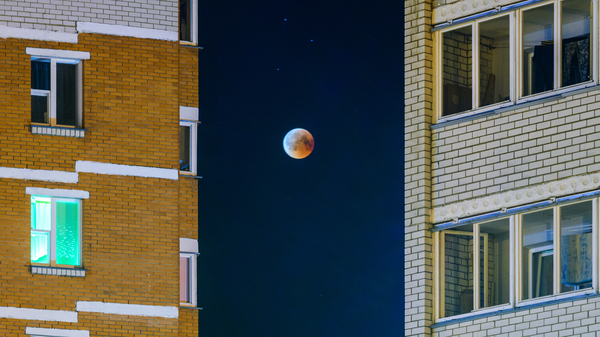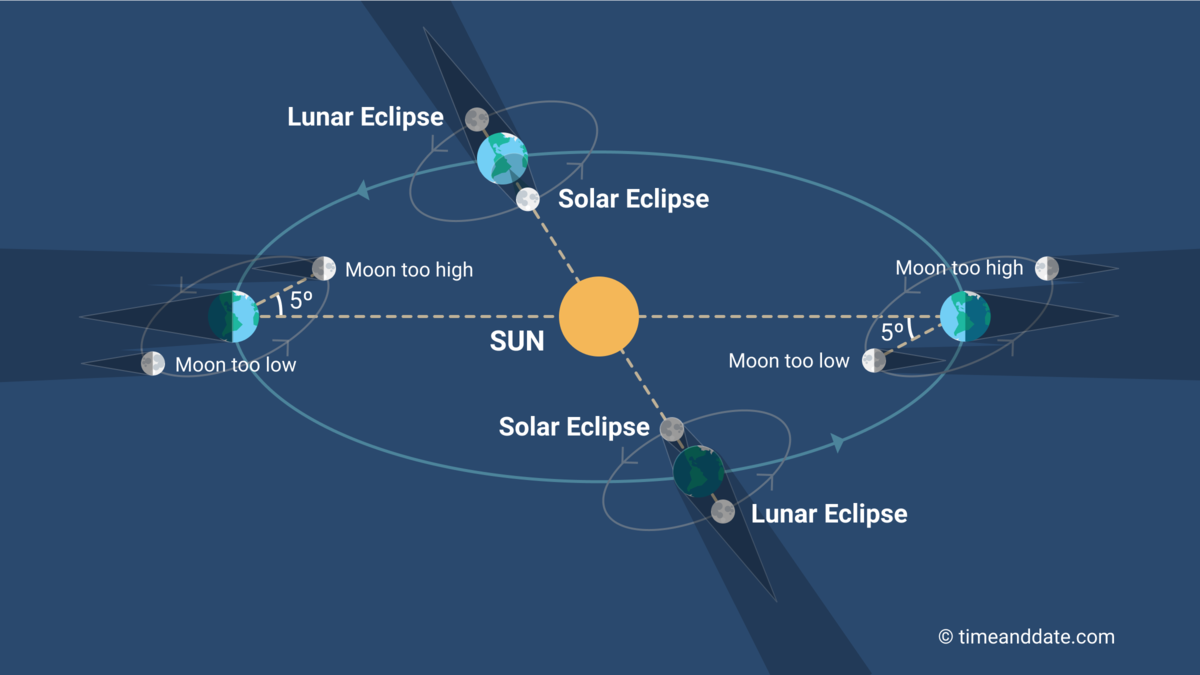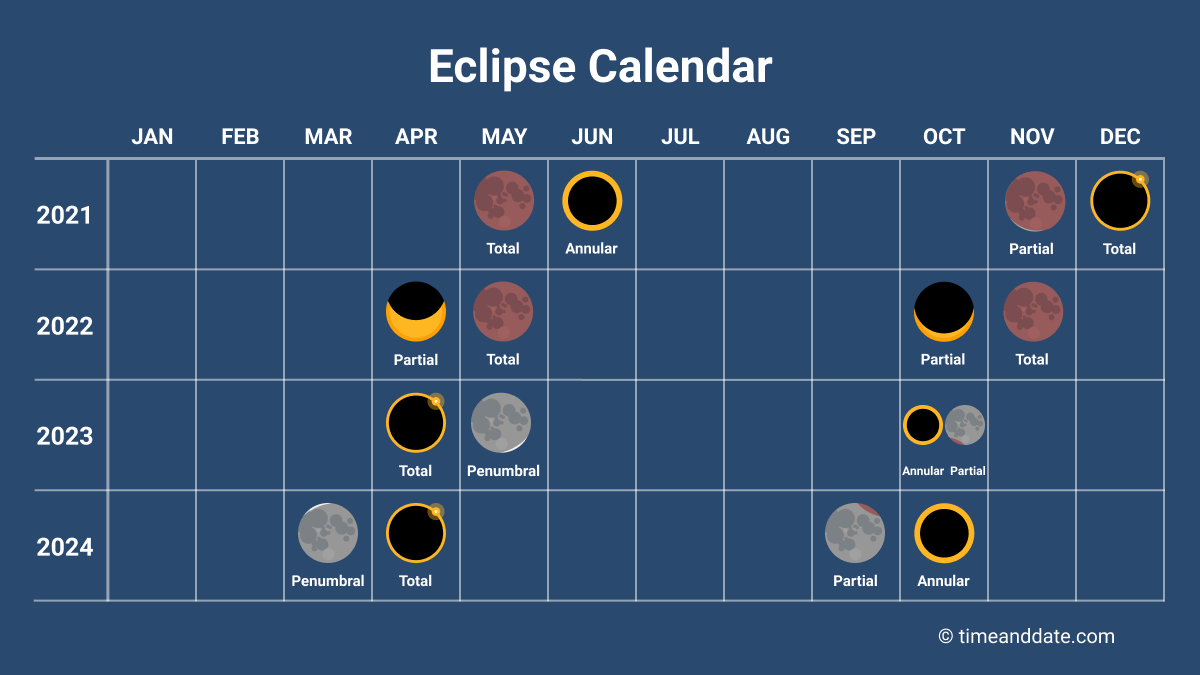Eclipse Seasons: What Are They, and Why Are Some Special?
Solar and lunar eclipses can only occur during a short period of time known as an eclipse season. No two eclipse seasons are the same, and some are particularly noteworthy.

An eclipse season features at least one lunar and one solar eclipse.
©iStockphoto.com/V_Sot
Eclipse Seasons in 2025
The two eclipse seasons of 2025 will favor lunar eclipses.
A total lunar eclipse on March 13–14 will be followed two weeks later by a partial solar eclipse across an area of North America and Europe on March 29.
Watch eclipses LIVE on timeanddate.com
Six months after that, there will be another total lunar eclipse on September 7–8, paired with a partial solar eclipse across a southern region of the globe on September 21.
Eclipses Need a New Moon or a Full Moon
The basic requirement for a solar eclipse is a New Moon, which occurs when the Moon passes between the Earth and the Sun. A lunar eclipse requires a Full Moon, when the Moon is on the opposite side of Earth to the Sun.
The Moon takes around 29.5 days to go through all its phases, and New Moons and Full Moons are separated by about two weeks.

The New Moon is the "invisible" phase. But it can be spectacularly noticeable during a solar eclipse.
©iStockphoto.com/MHafizzuddin
Eclipses Don't Happen Every Month
The Moon's orbit around Earth is tilted by about 5.1 degrees to Earth's orbit around the Sun. This is why eclipses don't happen every month: at New Moon and at Full Moon, more often than not, the Moon is too high or too low to align precisely with the Earth and the Sun.


The Moon's orbital tilt means that perfect alignments can only happen every six months or so.
©timeanddate.com
Eclipses Come in Seasons
About every six months, Earth comes to a sweet spot in its orbit where a perfect—or almost perfect—three-way alignment of the Earth, Moon, and Sun can occur. Each sweet spot lasts for about 34.5 days: an eclipse season.
If there is a New Moon near the middle of an eclipse season, it will form a straight line with the Earth and the Sun. The result will be a total solar eclipse, or an annular solar eclipse, if the Moon is too far from Earth to cover the Sun completely. In a similar way, a Full Moon near the middle of an eclipse season will produce a total lunar eclipse.
What is a Hybrid solar eclipse?
On the other hand, if a New Moon or a Full Moon comes near the beginning or end of an eclipse season, the three-way alignment will be not quite perfect. In this case, the result will be either a partial solar eclipse, a partial lunar eclipse, or, if the Moon passes through only the faint outer part of Earth's shadow, a penumbral lunar eclipse.
Eclipses Guaranteed
Since a lunar month (the time taken for the Moon to go from New to Full to New again) is only 29.5 days, each eclipse season is guaranteed to produce—somewhere in the world—one solar eclipse and one lunar eclipse. There can also be a second solar or lunar eclipse, if the first one occurs in the first few days of the season.
Eclipses in Balance
In most cases, the solar and lunar eclipses within each season balance each other: if one is a full eclipse, the other tends to be partial. To put it another way, if the alignment of the Earth, Moon, and Sun is perfect for one eclipse, the other eclipse will likely be near the beginning or end of the season, when the alignment is less perfect.
For example, the “Great American” total solar eclipse of August 21, 2017 was preceded by a small partial lunar eclipse 14 days earlier. And the total lunar eclipse of July 27, 2018—the longest of the 21st century—was sandwiched between two small partial solar eclipses (on July 13 and August 11).


Looking ahead to future eclipses, this calendar shows how a total eclipse is often—but not always—balanced by a partial or penumbral eclipse. (Click on the image for a larger size.)
©timeanddate.com
Two Full Eclipses in One Season
Occasionally, however, both the New Moon and the Full Moon fall close enough to the midway point of a season to produce a pair of full eclipses. It is possible to fit in two full eclipses like this, but it's a squeeze: in each case, the alignment of the Earth, Moon, and Sun is only just good enough to produce a full eclipse.
Again, there is a balance between the two eclipses. The better the alignment is for one, the worse it will be for the other. This is what made the first eclipse season of 2021 especially interesting.
The May-June 2021 Eclipse Season
This eclipse season produced a pair of full eclipses: a total lunar eclipse on May 26, 2021, and an annular solar eclipse on June 10, 2021. Although this kind of pairing is not rare—it happens, on average, once every eight years or so—this specific pair was unusual.
When two full eclipses are squeezed into a single fortnight, the alignment of the Earth, Moon, and Sun for each event is only just good enough to produce totality or annularity.
A Short Lunar Eclipse...
This was especially true for the total lunar eclipse on May 26, 2021. Totality lasted a little over 14 minutes, making it the 10th shortest totality for any lunar eclipse between the years 1600 and 2599.
In terms of the total worldwide duration of the eclipse, which includes partial and penumbral phases, the May 26 event was even more exceptional: it is the 2nd shortest of all 693 total lunar eclipses in the same 1000-year timespan.
...and a Long Solar Eclipse
Within the same period, the June 10 annular solar eclipse was also notable for its length. Although it was not particularly long when compared to solar eclipses in general, it stands out as having the 5th longest worldwide duration (including partial phases) of any total or annular solar eclipse that is paired with a total lunar eclipse in the same eclipse season.
Worldwide Duration of Eclipses
Between the years 1600 and 2599, there are 2108 eclipse seasons. Of these, 126 seasons contain a pair of full eclipses: one total or annular solar eclipse, plus one total lunar eclipse.
At timeanddate.com, we looked at the worldwide duration of each eclipse in these pairs. This is the length of time between the first and last moments the eclipse is visible from somewhere in the world, including partial and penumbral phases.
Generally speaking, the better the alignment of the Earth, Moon, and Sun, the longer the worldwide duration of the eclipse. (There are several ways to measure how closely the three bodies are aligned, such as the magnitude of the eclipse, or a more technical number referred to as gamma. However, for fun, we looked at the total length of the eclipse in seconds.)
How These Eclipses Compared to Others
The worldwide duration of the annular solar eclipse on June 10, 2021 was 17,939 seconds, or just under five hours. For a full solar eclipse that occurs in the same season as a total lunar eclipse, this turns out to be unusually long: it is the 5th longest solar eclipse in our 1000-year sample of 126 pairs of full eclipses.
This means that the worldwide duration of the total lunar eclipse on May 26, 2021 was likely to be short—and indeed it was. Its total length of 18,127 seconds, or just over five hours, may not seem that quick. But for a lunar eclipse that includes penumbral, partial, and total phases, it was exceptionally fast.
Across all 2108 eclipse seasons in the period 1600 to 2599, there are 695 total lunar eclipses. Only one of these has a shorter worldwide duration than the May 2021 eclipse. It is literally a few seconds shorter—four seconds, to be precise—and it will occur 345 years from now (on May 25, 2366).

At maximum eclipse on May 26, Earth's umbral shadow only just covered the face of the Moon.
©timeanddate.com
If we consider only totality—in other words, if we ignore the partial and the penumbral phases—the May 2021 eclipse had a duration of 858 seconds (about 14 minutes). By this criteria, it is the 10th shortest of all 695 total lunar eclipses in our sample period of one millennium.
Note on the Accuracy of Eclipse Predictions
All eclipse predictions contain a small margin of error. One of the uncertainties in lunar eclipse calculations, for example, is that the atmosphere gives Earth's shadow a fuzzy edge.
This can lead to borderline cases such as October 17, 2024. We classify this as an “almost” lunar eclipse, while some sources list it as a penumbral eclipse.